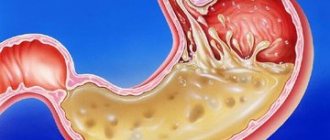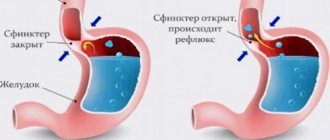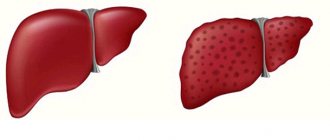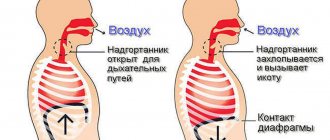Causes of heartburn and nausea at the same time
Heartburn and nausea after eating can occur at the same time, and in some cases, nausea can begin after the burning sensation in the chest. Common causes of symptoms:
- binge eating;
- abuse of fatty, fried, difficult-to-digest foods;
- smoking;
- alcohol consumption;
- taking medications that relax the sphincter between the stomach and esophagus;
- consumption of products containing caffeine and cocoa beans;
- pregnancy, especially the last trimester;
- overweight;
- tight clothing that puts pressure on the stomach 5.
Mechanism of symptom formation
The main component of gastric juice is hydrochloric acid. It works as an activator of digestive enzymes and is an important part of food digestion. Thanks to it, an acidic environment is formed in the stomach, and the organ itself has a special mucous layer that protects against irritation.
Under the influence of certain factors, a bolus of food with enzymes and hydrochloric acid enters the esophagus from the stomach. This organ does not have a protective layer, and the environment is normally alkaline. Therefore, the acid chemically burns the walls of the esophagus, which causes a burning sensation1.
Most often, the symptom occurs 15-30 minutes after eating and may be accompanied by nausea6. The association of a burning sensation behind the sternum with food intake makes it possible to distinguish the condition from heart problems5.
Causes of sour belching
Physiological acid burping
Sometimes spontaneous release of sour-tasting gases occurs in healthy people and is associated with certain dietary habits or other physiological reasons. In some situations, such belching is considered normal and is not considered a symptom of diseases of the digestive tract. Among the causes of non-pathological acid erection are:
- Eating certain foods
. Spicy dishes, meat products, rich broths stimulate the production of gastrin in the stomach, which leads to increased secretion of hydrochloric acid. Acid erection, as a rule, occurs 20-30 minutes after eating irritating food and is combined with heartburn and discomfort in the epigastric region. In typical cases, symptoms disappear on their own and do not require drug therapy. - Pregnancy
. Acid belching in pregnant women is provoked by two main factors: an increase in intra-abdominal pressure and an increase in progesterone activity. As a result, gastrointestinal motility disorders occur, excessive relaxation of the lower esophageal sphincter occurs, which is accompanied by frequent reflux of stomach contents into the pharynx and mouth. The condition worsens when bending the body, in a lying position.
Acid reflux in esophageal pathology
The reflux of acidic chyme into the pharynx and oral cavity during GERD is associated with insufficiency of the esophageal obturator apparatus and spontaneous opening of the lower esophageal sphincter. As a result, aggressive gastric contents with a low pH level periodically enter the mouth through the esophagus. Belching in patients is often accompanied by other unpleasant symptoms - chest pain, heartburn. The most common causes of the appearance of a pathological symptom:
- Reflux esophagitis
. Acid erection often develops against the background of severe pain along the esophagus and is caused by improper functioning of the esophageal sphincter. Its functioning is normally regulated by the level of gastric acidity - the muscular system closes after food enters the stomach and significant production of hydrochloric acid. With GERD, the sphincter spontaneously opens and releases chyme with an acidic pH. - Diaphragmatic hernia
. The exit of the gastric cardia into the chest cavity through the esophageal opening in the diaphragm is accompanied by disruption of the lower esophageal sphincter. Acid belching is often combined with substernal and precordial pain, and swallowing disorders. Involvement of autonomic nerves in the pathological process sometimes leads to the development of a clinical picture reminiscent of an angina attack. - Other diseases of the esophagus
. For functional motor disorders, regurgitation of eaten food or rotten belching is more typical, but sometimes acidic erection with liquid contents occurs. At the initial stage of hypomotor dyskinesia of the esophagus and achalasia cardia, discoordinated muscle contractions of the esophagus are observed, which can spread to the smooth muscles of the stomach. At the same time, contractile activity increases, which, in combination with the gaping of the cardia, leads to acidic erection. The condition is aggravated by the addition of chest pain and discomfort after eating.
Sour belching and hyperacid gastroduodenal diseases
Increased production of hydrochloric acid in the antrum of the stomach and a secondarily developing disorder of the contractile function of the cardiac sphincter provoke erection with a pronounced sour taste. Hypersecretion in the stomach can occur for various reasons; it is usually associated with organic diseases of the gastroduodenal zone, in which there is an increase in the activity of parietal cells of the mucous membrane. The most common diseases that lead to the development of belching are:
- Antral gastritis
. Dyspeptic disorders are the main manifestation of inflammation of the mucous membrane of the gastric body, which in 95% of cases is caused by H. pylori. As a result of the aggressive influence of bacteria, the synthesis of bicarbonates, which have an alkalizing effect, stops, and the muscle layer contracts with acidic contents being thrown into the oral cavity. Gastritis is also characterized by frequent constipation and epigastric pain. - Zollinger-Ellison syndrome
. Acid erection develops due to the presence of a gastrin-producing benign tumor in the pancreas or duodenum, causing uncontrolled synthesis of hydrochloric acid. Constant low pH leads to damage to the mucous membrane of the stomach and esophagus, esophagitis. The disease is accompanied by severe abdominal pain, diarrhea and heartburn. - Gastroduodenal reflux
. Throwing the alkaline chyme of the duodenum into the stomach provokes activation of the production of hydrochloric acid and an increase in pressure inside the organ. As a result, a backflow of acidic contents into the esophagus and oral cavity occurs. The condition is accompanied by other signs of dyspepsia: cramping pain 30-40 minutes after eating, constant flatulence, heartburn. - Functional hypersecretion
. An increase in HCl production and associated acid belching can be observed with increased tone of the parasympathetic nervous system. Increased influence of the vagus nerve on acid-producing gastric cells leads to uncontrolled release of hydrochloric acid and disruption of the contractility of the esophageal sphincter. Autonomic symptoms are noted: facial redness, sweating. - Taking certain medications
. Hyperacid secretion may result from long-term use of medications such as acetylsalicylic acid and corticosteroid hormones. These drugs potentiate the disruption of gastric protective factors, activate parietal cells and cause a decrease in pH in the stomach. The symptoms are similar to the clinical manifestations of acute gastritis: nausea, pain in the epigastric region, and vomiting.
Belching sour and hypoacid pathology of the stomach
The appearance of acid erection in diseases accompanied by reduced gastric secretion is due to disturbances in the processes of food digestion and the movement of chyme through the gastrointestinal tract. When the food bolus stagnates in the stomach, organic acids (lactic, butyric and others) are formed. These compounds increase acidity, and stretching of the walls of the organ causes a reflex contraction of the muscles and reflux of the contents into the oropharynx. In this case, the patient feels a characteristic sour taste. Erection is most often caused by:
- Atrophic gastritis
. Atrophy of the gastric mucosa usually occurs with prolonged persistence of Helicobacter pylori infection. A decrease in the number of exocrine glands leads to prolonged stagnation of food and its decomposition. Belching is accompanied by nausea, heaviness in the stomach, and lack of appetite. Due to impaired motility of the digestive tract, the patient may experience severe weakness, pallor, and diarrhea after eating. - Autoimmune gastritis
. In the autoimmune variant of inflammation, which accounts for 1% of all cases of gastritis, the hypoacid state is associated with primary damage to the acid-producing glands of the stomach. Acid erection is usually combined with a tendency to constipation, heaviness in the stomach, and weight loss. Autoimmune gastritis is characterized by specific symptoms: burning sensation in the tongue, fatigue, paresthesia, drowsiness. - Achlorhydria
. The absence of HCl in the stomach is accompanied by disturbances in the digestion of food (primarily protein) and increased formation of organic acids. The condition occurs with concomitant diseases of the gastrointestinal tract, and can be a consequence of endocrine pathology, uremia. In addition to erection, patients are concerned about dull pain and bloating in the stomach after eating, bloating, and nausea.
What other symptoms might bother you?
The causes of heartburn and nausea after eating can be either physiological or indicate serious illnesses. Additionally, symptoms such as:
- one-time vomiting;
- pressure in the abdomen, feeling of fullness;
- pain in the upper abdomen;
- pain behind the sternum (with the formation of erosions and ulcers of the esophagus);
- belching acid;
- sour feeling in the mouth5.
Warning symptoms requiring professional intervention:
- burning is accompanied by dark vomit like “coffee grounds” or blood;
- the appearance of tarry stools (black);
- the symptom bothers you continuously for several days;
- difficulty swallowing food, shortness of breath;
- severe abdominal pain, associated and not associated with heartburn;
- continuous noticeable weight loss for no apparent reason;
- connection of heartburn not with food intake, but with medications3.
If at least one of the listed manifestations occurs, you should undergo a special examination to identify the exact cause of the condition.
Diagnostic methods
If heartburn and belching occur constantly, an examination is required. Frequent occurrence of symptoms usually indicates the presence of some pathology. To identify the cause, the following research methods are prescribed:
| Research method | Explanation |
| Daily pH monitoring in the esophagus | The study is prescribed to identify gastroesophageal reflux (reflux of gastric contents into the esophagus). Using daily pH-metry of the esophagus, you can determine: · number of episodes of pH changes (refluxes); · their duration; · connection with food intake, body position; · influence of drugs on the occurrence of reflux. |
| Manometric examination of the esophageal sphincters | Allows you to identify changes in the tone of the lower esophageal sphincter. A decrease in its tone often causes the appearance of gastroesophageal reflux and belching. |
| Fibrogastroduodenoscopy (FGDS) | An endoscopic examination is prescribed to assess the condition of the mucous membrane of the esophagus and stomach. With the help of FGDS, inflammatory changes, erosions, ulcers, and strictures of the esophagus can be detected. |
| Detection of Helicobacter pylori infection | Often, constant heartburn and belching are symptoms of gastritis caused by the bacterium Helicobacter pylori. Different methods can be used to detect infection: · determination of Helicobacter pylori in feces; · urease breath test; · endoscopic examination with biopsy. |
Why do heartburn and nausea need to be treated?
Even if the cause of heartburn and nausea is not diseases of the gastrointestinal tract (GIT), the problem should not be ignored. Frequently recurring symptoms gradually lead to the formation of the following problems:
- Esophagitis is inflammation of the walls of the esophagus. Due to constant burns, wounds are formed into which bacteria enter and an inflammatory process develops3.
- GERD – gastroesophageal reflux disease. Develops due to persistent relaxation of the esophageal sphincter6. Most often it accompanies diseases of the digestive system, that is, it occurs secondarily. But there are cases of the development of primary GERD, which is a chronic disease that requires an integrated approach.
- Narrowing of the esophagus. Ulcers on the walls of the organ become scarred, causing the lumen of the esophagus to narrow. It is difficult for a person to pass food, which significantly impairs the quality of life.
- Barrett's esophagus. Long-term damage to an organ by hydrochloric acid can provoke degeneration of the epithelial cells lining the walls. The disease is considered precancerous and can lead to the development of cancer1.
Stomach ache
Symptoms
When they say that the stomach hurts, they usually mean colic and cramps. They can be barely noticeable, or they can literally twist your stomach. In this case, the stomach is usually swollen or tense. It is from such colic that babies often wake up and cry.
Causes
Sleep and microbiota: how appetite and digestion relate to sleep quality
One possible reason is flatulence. Excess gases stretch the intestinal walls and thereby cause pain as they move along the tract. People with sensitive guts are especially susceptible to this pain.
Also, the stomach may hurt due to stress or a disrupted daily routine, in which you have to snack chaotically or endure hunger, and then eat too much late in the evening.
Another reason is inflammation of the intestinal mucosa caused by intestinal flu or other infection. Colic and cramping may also be due to a chronic condition such as gastroparesis, irritable bowel syndrome, Crohn's disease, or liver damage.
Irritable bowel syndrome: how does stress affect digestion?
In babies, there can be several causes of colic: developing microflora, lack of enzymes, increased sensitivity of the intestines, intolerance to formula feeding, swallowing air.
Principles of heartburn treatment
Medicines for heartburn and nausea are not enough to fully combat the unpleasant condition. The basis of treatment is lifestyle correction and diet. Recommendations include:
- eating small portions 3-4 times a day;
- refusal of sour, spicy, smoked foods and foods with chemical additives, carbonated drinks, alcohol, cabbage, onions, tomatoes;
- limiting the consumption of baked goods, coffee, tea, fatty foods, sweets, sausages, fried foods;
- after eating, a quiet walk in the fresh air is recommended; it is forbidden to take a horizontal position;
- normalization of work and rest, sleep, avoidance of stressful situations;
- avoiding intense physical activity after meals, especially bending forward;
- increasing the motor activity of the body as a whole5.
Proton pump inhibitors are considered one of the most effective medications for treating heartburn6. The action of these drugs allows not only to remove the symptom, but also affects the mechanism of burning sensation. One of the representatives of the group is Omez 10 mg, a drug based on Omeprazole. It is convenient to take 2 capsules once a day, which helps eliminate the symptoms of heartburn within 24 hours2. The drug allows treatment courses of up to 14 days without consulting a specialist.
How to deal with heartburn?
If heartburn occurs occasionally, you should reconsider your diet and eating habits, as well as change some daily habits. General recommendations for preventing recurrent heartburn from sweets:
- Eating small meals at least 3 times a day. Dinner should be 2-3 hours before bedtime.
- After eating, it is recommended to take a walk in the fresh air. But under no circumstances should you lie down.
- Food should be varied and contain the necessary macro- and microelements. It is recommended to avoid fried, fatty, spiced, smoked and canned foods. You need to add proteins and plant foods to your diet. Simple carbohydrates should be limited as much as possible.
- Normalize your body weight. Increase physical activity, but it should not be done immediately after eating. Watch your caloric intake.
- Give up bad habits. Smoking helps relax the esophageal sphincter. Alcohol increases acid production.
- Wear comfortable clothes. Do not tighten your waist with belts on trousers, coats, or robes. This physically promotes the reverse movement of food.
- It is recommended to sleep with the head end elevated.
- You should avoid physical activity that involves lifting heavy objects, bending over, or straining your abdominal muscles2,3.
Additionally, you can use medications that alleviate the condition. Many people are familiar with antacids to combat heartburn. These medications neutralize stomach acid. To influence the very cause of heartburn, drugs are used that suppress acid production - proton pump inhibitors,3.
Why can't you use soda?
The most famous home remedy for eliminating a burning sensation behind the sternum is baking soda. Alkali neutralizes hydrochloric acid, thereby eliminating the unpleasant symptom. However, it has been proven that the use of this method of treatment only causes harm. In the process of neutralizing the acid, a large amount of carbon dioxide is released, which distends the stomach. This can cause damage to the mucous membrane, and in the presence of an ulcer, even bleeding5. In addition, the environment in the stomach must remain acidic. Therefore, after using soda, the compensatory mechanism for the production of hydrochloric acid starts almost immediately. The result may be even more severe discomfort in the stomach and esophagus5.
Prevention
Proper diet and nutrition are the basis for successfully preventing heartburn and nausea. Additional recommendations:
- rejection of bad habits;
- correct work and rest schedule;
- weight loss;
- refusal of uncontrolled use of NSAIDs;
- wearing loose clothing without tight belts or corsets.
Timely treatment of diseases of the digestive system accompanied by heartburn, including recommendations for the use of Omez 10 mg, helps relieve heartburn.
THERE ARE CONTRAINDICATIONS, YOU MUST READ THE INSTRUCTIONS FOR MEDICAL USE OR CONSULT A DOCTOR.
Bibliography:
- Strugala V. et al. A randomized, controlled, crossover trial to investigate times to onset of the perception of soothing and cooling by over-the-counter heartburn treatments // Journal of International Medical Research. - 2010. - T. 38. - No. 2. - P. 449–457.
- INSTRUCTIONS for the use of the medicinal product for medical use. OMEZ 10 mg LP 00328 dated 07/11/17 Date of appeal 11/26/18.
- Komarov F.I., Osadchuk M.A., Osadchuk A.M. Practical gastroenterology. Medical news agency. Moscow, 2010. - 480 p.
- Lazebnik L.B., Masharova A.A., Bordin D.S. and others. Results of the multicenter study “Epidemiology of gastroesophageal reflux disease in Russia” (MEGRE). Therapeutic archive. — 2011. No. 1.— P. 45-50.
Osadchuk A.M., Davydkin I.L., Gritsenko T.A., Khairetdinov R.K., Kurtov I.V., Danilova O.E., Rogozina L.A., Kosyakova Yu.A., Krivova S. .P. HEARTBURN SYNDROME. CURRENT ISSUES OF PATHOGENESIS, DIFFERENTIAL





